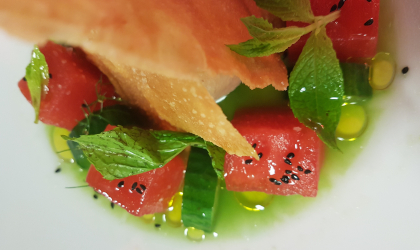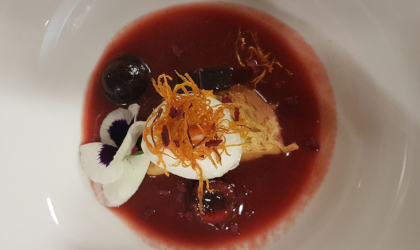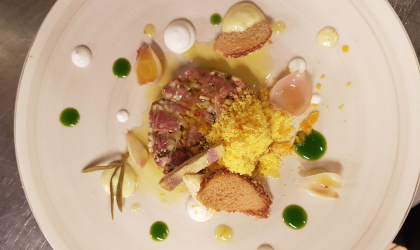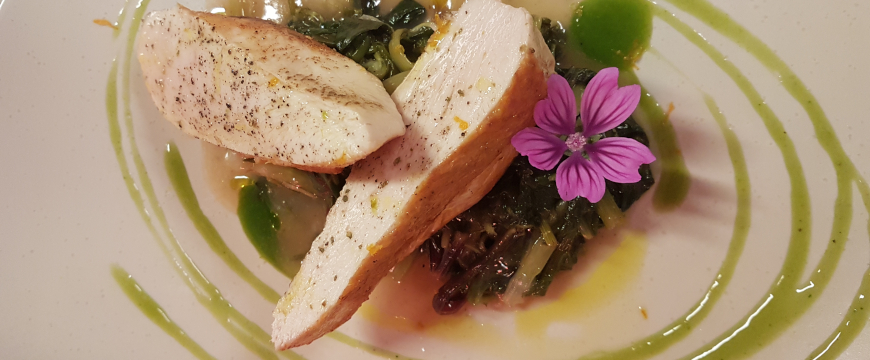Chef Vasilis Leonidou strives “to blend the right olive oil into my recipes to impart character and balance between the ingredients and the olive oil.” He also enjoys experimenting with “rare and unique varieties of EVOO that chefs do not use very often in restaurants because of their complexity.” His results have drawn the attention of influential critics.
While working as the executive olive oil chef at Kapsaliana Olive Village Hotel near Rethymno, Crete, Greece, Leonidou was judged the “Best Olive Oil Chef” in the world for 2017 by Flos Olei, an international olive oil guide from Italy. Currently the executive chef at Avli restaurant in Rethymno and an educator at the GRANT Institute of Technology and Education in the same city, Leonidou has been cooking since he was nine years old.

Leonidou has come a long way since then, and even in the past decade. Now he works with more than 45 extra virgin olive oils (EVOOs) from various countries—and looks forward to trying all the other varieties in existence. In 2010, however, a Greek olive oil taster complimented his cooking but added, “you have a very bad olive oil.” Tasting olive oil with guidance from a trained taster for the first time, Leonidou realized that was true and decided to educate himself about “the most important product in Greece.” He told Greek Liquid Gold he soon learned “that the raw material, olive oil, has to be extra virgin and not have any defects.”
By 2015, Leonidou had learned enough from Greek and Italian experts to earn the title “Master and Sommelier of Extra Virgin Olive Oils.” However, he prefers to be called an “Executive Olive Oil Chef,” since this more accurately reflects his experience as “one of the first chefs who really worked a lot with EVOOs” in Greece.
Praising the well balanced flavor of many Greek extra virgin olive oils, Leonidou is aware of the “personal character and taste” of all the EVOOs he works with. He looks for high intensity bitterness and spiciness, as well as “extra natural tastes” in olive oil such as hints of greens, tomato, or citrus. He explores until he finds the right combination—the best EVOO with a perfect tomato, in a chicken or lamb dish, even with fresh fruits, ice creams, desserts, and smoothies.

Leonidou’s creations include
• Chicken breast with greens and avgolemono (egg and lemon) sauce served with Tsounati olive oil
• Feta mousse with cucumber, watermelon, mint, crispy phyllo, fresh cucumber juice, and Nemoutiana Olympia olive oil
• Greek tsoureki (brioche) cherry soup with yogurt ice cream, carrot, and Megaritiki olive oil
• Lamb tartare with yogurt-almond sauce and Koroneiki olive oil (recipe below)
Chef Leonidou advises consumers trying a new oil to purchase a small quantity of a branded extra virgin olive oil. If they are pleased with the flavor and notice no defects, they can go on to purchase a larger amount. He encourages everyone to use up an open bottle of extra virgin olive oil within three or four months in order to enjoy all of its benefits, including vitamins and the naturally occurring anti-inflammatory and antioxidant compounds called polyphenols.
Leonidou’s motto:
OLiveTOLive
OLive for Health
Recipe for Lamb Tartare with Yogurt-Almond Sauce
By Vasilis Leonidou

Caution: be sure to purchase your lamb from a trustworthy butcher and keep it well chilled.
Ingredients
(for a single serving; multiply all amounts to serve more than one)
- 1 piece traditional bread ring or bagel with sesame (for crouton)
- Koroneiki variety extra virgin olive oil (such as one from Sitia, Crete)
- black pepper
- salt
- 100 g (3.5 ounces) lamb fillet
- ice
- juice and zest (divided) of 1 lemon
- 50 g (almost 1 cup) onion, finely chopped
- 10 g (a bit more than 1 tablespoon) caper, divided (half for the sauce, half for the marinade)
- 1 teaspoon of mustard
- 100 g (3.5 ounces) raw almonds
- 50 g (3 tablespoons + 1 teaspoon) yogurt
- 10 g (1 teaspoon) fresh chopped dill
- 10 g (1 teaspoon) fresh chopped mint
- 10 g (1 teaspoon) fresh chopped parsley
- More herbs to garnish
- 1 pickled artichoke to garnish
- 1 samphire to garnish
Directions
1. Preheat oven to 150 degrees Celsius. Cut the bread ring or bagel into thin slices and sprinkle them with salt, pepper, and olive oil. Bake for approximately 20 minutes, until crispy.
2. Remove the skin and fat from the lamb fillet, then cut the meat into small pieces with a sharp knife. Place the pieces in a bowl, and place that bowl inside a larger bowl full of ice. Add a pinch of salt, half of the zest and all but a teaspoon of the juice from the lemon, the onion, half of the caper, a pinch of black pepper, the mustard, and 2 tablespoons of olive oil. (Reserve the rest of the lemon zest and juice for the yogurt almond sauce.) Stir, then let the mixture marinate for 8 to 10 minutes.
3. While waiting, prepare the yogurt almond sauce (a recipe from Sitia, Crete). Use a sharp knife to chop the almonds into tiny pieces, then mix them with the yogurt, dill, mint, parsley, remaining caper, and remaining lemon zest and lemon juice.
4. Place the meat on a cold plate, with the yogurt almond sauce next to it. On top of the sauce, add more herbs for more flavor. On top of the meat, add slices of artichoke, samphire, black pepper, and a drizzle of good Koroneiki variety extra virgin olive oil.
Kali orexi (Kαλή όρεξη) – Bon appetit!
Thanks to Vasilis Leonidou for sharing the recipe and the photos.
All businesses, organizations, and competitions involved with Greek olive oil, the Mediterranean diet, and/or agrotourism or food tourism in Greece, as well as others interested in supporting Greeks working in these sectors, are invited to consider the advertising and sponsorship opportunities on the Greek Liquid Gold: Authentic Extra Virgin Olive Oil website. The only wide-ranging English-language site focused on news and information from the Greek olive oil world, it has helped companies reach consumers in more than 215 countries around the globe.


